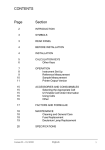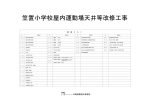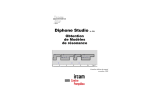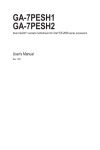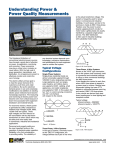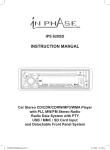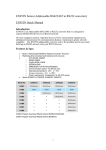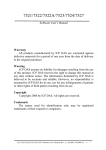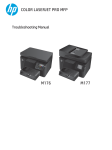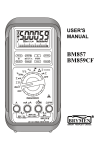Download 509 509THD
Transcript
509 509THD TRUE-RMS MULTIMETER WITH RS-232C Please read before using this equipment. USER’S MANUAL a world leader in test & measurement FINE INSTRUMENTS CORPORATION 341-5, SONGNAE-DONG, SOSA-GU, BUCHON-SHI, KYUNGGI, KOREA -TEL:(82-32) 656-8771~4 -FAX:(82-32) 656-5844 -E-mail:finest @ktnet.co.kr © Copyright 1999 Fine Instruments Corp. All right reserved. Specifications subject to change without notice. Litho in Korea. Measurement Limits: DC Voltage : 0.1 mV to 1000 V AC Voltage : 1 mV to 750 V DC Amps : 0.1 µA to 10 A AC Amps : 0.1 µA to 10 A Resistance : 0.1 Ω to 40 MΩ Capacitance : 0.001 µF to 999 µF SOURCES LIKE SMALL HAND-HELD RADIO Frequency : 0.5 Hz to 200 kHz TRANSCEIVERS, FIXED STATION RADIO AND Temperature : - 40 °C to + 1,370 °C (- 40 °F to + 2,498 °F) TELEVISION TRANSMITTERS, VEHICLE RADIO Continuity Check : Beep at Approx. < 100 Ω in the 4 KΩ range TRANSMITTERS AND CELLULAR PHONES THD @ 50/60Hz® : 0.0% to 99.9% [509 THD Only] WARNING! GENERATE ELECTROMAGNETIC RADIATION THAT MAY INDUCE VOLTAGES IN THE TEST LEADS OF THE MULTIMETER. IN SUCH CASES THE ACCURACY OF THE MULTIMETER WARNING! READ “SAFETY CONSIDERATIONS” BEFORE USING THIS METER. CANNOT BE GUARANTEED DUE TO PHYSICAL REASONS. CONTENTS 1. Introduction 2. Safety Considerations 3. Explanation of Controls and Indicators 4. Basic Electrical Tests and Measurements 5. RS-232C Interface 6. Maintenance and Battery/Fuse(s) Replacement 7. Accessories 8. Specifications 2 3 5 17 36 46 48 49 1 1. INTRODUCTION This Meter is a handheld and battery operated instrument that is designed and tested according to IEC Publication 1010-1 (EN 61010-1) (Overvoltage Category ll), the EMC Directive (EN 500811 and EN 50082-1) and other safety standards (see “Specifications”). Features: ■THD @ 50/60Hz ® measurement (Optional) ■33/4 digit, 4000 count with 41 segment bar graph ■Auto/manual ranging ■Safety shutter to prevent incorrect connections to current terminals ■Fused 10 Amps range ■Back-light ■True RMS on AC voltage and current ranges ■Auto-Power-Off Mode ■DC voltage basic accuracy within 0.3% ■Fix Hold TM (Automatic reading hold) Fix Hold TM is a trademark of Fine Instruments Corp. THD @ 50/60Hz ® is a registered trademark of Fine instruments Corp. ■Capacitance measurement ■Frequency measurement ■Temperature measurement ■ Continuity beeper and diode test ■Recording, offset and relative mode ■Comparator, GO-NO GO and percentage programming feature ■600 volt input protection on ohm range ■Hold and Low-battery annunciators 2 ■Rubber boot (or Safety holster) ■Large LCD display (68.5 mm x 32.7 mm) ■RS-232C interface 2. SAFETY CONSIDERATIONS Before using this Meter, read the following safety information carefully. In this manual, the word “WARNING” is used for conditions and actions that pose hazard(s) to the user; the word “CAUTION” is used for conditions and actions that may damage this Meter. International Symbols Dangerous Voltage ( Risk of electric shock) Not Applicable to Identified Model Alternating Current (AC) Direct Current (DC) Either DC or AC Diode Capacitor Ground (Allowable applied voltage range between the input terminal and earth) Caution! Refer to the user’s manual before using this Meter. Double Insulation (Protection Class ll) Fuse 3 WARNING! 3. EXPLANATION OF CONTROLS AND INDICATORS OBSERVE ALL SAFETY PRECAUTIONS WHEN MEASURING HIGHER VOLTAGES (AND/OR CURRENTS). TURN OFF POWER TO THE CIRCUIT UNDER TEST, SET THIS METER TO THE DESIRED FUNCTION AND RANGE, CONNECT THE TEST LEADS TO THIS METER AND THEN TO THE CIRCUIT UNDER TEST. REAPPLY POWER. IF AN ERRONEOUS READING IS OBSERVED, DISCONNECT POWER IMMEDIATELY AND RECHECK ALL SETTINGS AND CONNECTIONS. Safety Tips: • Do not try to measure any voltage that exceeds 1000V DC or 750V AC RMS. • Voltages above 60V DC or 25V AC RMS may create a serious shock hazard. • Do not attempt to use this Meter if either the Meter or the test leads have been damaged. • Turn off power to the circuit under test before cutting, desoldering, or breaking the circuit. Small amounts of current can be dangerous. • Disconnect the live test lead before disconnecting the common test lead. • When using the test leads, keep your fingers away from probe contacts. Always grip behind the finger guards on the probes. • Use a current clamp if measuring any current above 10 Amps. 4 5 the LO (low) reference value. If the compared reading is between the HI(high) reference and the LO (low) reference, a symbol “PASS” will be displayed on the LCD. DIGITAL DISPLAY. Digital readings are displayed on a 4000 count display with polarity indication and automatic decimal point placement. When this Meter is turned on, all display segments and symbols appear briefly during a selftest. The display updates four times per second. ANALOG BAR GRAPH. The bar graph provides an analog representation of readings and updates 20 times per second. The 41 segment bar graph illuminates from left to right as the input increases. If the input equals or exceeds 4000 counts on the range selected, the bar graph displays an arrow at the far right of the display in case of positive input (an arrow at the far left in case of negative input). Press the arrow (↑) button to increase the blinking number displayed on the LCD by 1 digit when the Meter is in the Editing mode. ⑥ (Display Back-Light). Press the HOLD button for 2 seconds to turn on the back-light. Back-light turns off automatically after 60 seconds to extend battery life. To turn off the back-light even before 60 seconds, press The HOLD button for 2 seconds again. Once the HI (high) reference value is entered (stored), press the HI/LO button to enter the LO (low) reference value into the meter. When you press the HI/LO button, the arrow at the left of the bar graph will come on. This indicates that the value you will put in is the LOW (low) reference value. Using the arrow (↑, ↓, →, and ←) buttons and the HOLD button enter the LO (low) reference value that you want your readings to be compared to. . Automatically captures a stable reading, beeps to acknowledge, and holds it on the LCD. But, simply freezes a reading when the Meter is in the Recording, Compare, Relative or Percentage mode. . (Enables GO-NO GO test when the Meter is in the Compare mode; works as an Increment button when the Meter is in the Editing mode). Press the CMP button to compare a reading with the stored HI (high) reference value and the stored LO (low) reference value. The “ C ” symbol turns on. A symbol “ – Hi– ” will be displayed on the LCD if the compared reading is higher than the HI(high) reference value and a symbol “ - LO - “ will be displayed on the LCD if the compared reading is lower than 6 (Programming the Reference value). Press the EDIT button to program a new reference value by using the arrow ( ↑, ↓, →, and ←) buttons when this Meter is in the Compare, Relative, or Percentage mode. You don’t need an external reference source in these modes. When you press the EDIT button, the “0” at the right side of the LCD will begin to blink and the arrow at the right of the bar graph will come on. This indicates that the value you will put in is the HI (high) reference value. Using the arrow (↑, ↓, →, and ←) buttons enter the HI(high) reference value that you want your readings to be compared to. Use the HOLD button to select “ ” sign. Press the EDIT button to exit this mode. ⑦ [ Selects the Manual Range mode in the NonEditing mode; Enables the Meter to store the HI (high) reference value or the LO (low) reference value in the Compare mode]. 7 HI/LO Press the RANGE button to select the Manual Range mode and turn off the “AT” symbol. (The meter remains in the range it was when manual ranging was selected.) When this Meter entered the Recordings mode, Auto Power Off is disabled and this Meter will automatically switch to Standby Mode after around 1 hour to save battery life unless you disabled the Standby Mode. To disable the Standby Mode, turn the rotary switch from OFF to any function (ON) position while holding down the HOLD button. Each time you press the RANGE button in the Manual Range mode, the range increases and a new value is displayed. If you are already in the highest range, the meter wraps around to the lowest range. To exit the Manual Range mode and return to autoranging, press and hold down the RANGE button for 2 seconds. The “AT” symbol turns back on. When the range is changed manually, the Recording, Percentage (%), Compare, Relative and Hold modes are disabled. If you press any ineffective button to the Recording mode, the Meter will sound 2 consecutive beeps to let you know that the button function does not work in the Recording mode. To exit this mode and erase recorded readings, hold the REC button down for 2 seconds. Press the HI/LO button to enable the Meter to edit and store the HI (high) reference value or the LO (low) reference value by toggling between the 2 reference values when the Meter is in the Compare mode. Press the HI/LO (RANGE) button to recall the stored reference value in the Compare, Relative or Percentage mode. ⑧ 8 . (Maximum, Minimum and Average Recording; A Left-Shift button when the Meter is in the Editing mode). Press the REC button to enter the Recording mode. The “ R ” symbol turns on. This function allows you to record Maximum, Minimum and Average values for a series of measurements on the same function and range. This Meter will beep every time a new maximum or minimum value is recorded. Press the REC button to scroll through the stored MAX, MIN and AVG values. When an overload is captured, a beeper tone emits and the Meter displays OFL(overload). This Meter can only record for 24 hours in this mode. Press the arrow (← ) button to shift the blinking number position to the left by 1 decimal point when the Meter is in the Editing mode. When the blinking number is at the very left, the number will stay at the same position even if you press the arrow (←) button. ⑨ . (Relative Readings in the Relative mode; A Rightshift button when the Meter is in the Editing mode). In the Relative mode, this Meter displays the difference between the stored reference value and the measured reading value. Press the REL button to enter the Relative mode. The “REL” symbol will come on the LCD and the bar graph pointer will be at the center of the scale. Press the EDIT button to program the reference value. Using the arrow (↑, ↓, →, and ←) buttons, enter the value you want the readings displayed in relation to. Once the value is entered, press the EDIT button to exit the Editing mode. To recall the stored value, press the HI/LO (RANGE) button. 9 All measurements will be displayed as the difference between the stored value and the measured value. Negative readings are lower than the stored value. Positive readings are higher than the stored value. Pushing the REL button again exits the mode. Press the arrow (→ ) button to shift the blinking number position to the left by 1 decimal point when the Meter is in the Editing mode. When the blinking number is at the very right, the number will stay at the same position even if you press the arrow (→) button. ⑩ ⑪ ⑫ (Total Harmonic Distortion measurement of the Line Voltage or Current at 50/60 Hz). [Model: 509THD Only] When measuring AC voltage or amperes in the 50Hz (or 60Hz) power line, press and hold down the DC/AC button for 2 seconds to select the THD @ 50/60Hz mode. This mode enables the user measure THD (Total Harmonic Distortion) in percentage (%) from the 50Hz (or 60Hz) power line. (See 4.5 THD @ 50/60Hz.) . (% Readings in the Percentage mode; A Decrement button when the Meter is in the Editing mode). In the Percentage mode, this Meter displays the difference in percentage between the stored reference value and the measured value. Press the % button. The “%” symbol will come on the LCD and the bar graph pointer will be at the zero on the scale. To recall the stored reference value, press the HI/LO (RANGE) button. When this Meter enter into the THD @ 50/60Hz mode, the digital reading (that is, the TRUE-RMS value of voltage and amperes being measured) disappears and the symbol, %, and decimal points are displayed on the LCD. After about 2 seconds from this moment, the THD value in percentage (%) will be displayed. To exit the THD @ 50/60Hz mode, press and hold down the DC/AC button for 2 seconds again. The symbol, “%”, disappears. This feature is typically found in much more expensive power analyzing meters. Press the EDIT button. Using the arrow buttons, enter the value you want the readings displayed as a percentage of. Once the value is entered, press the EDIT button to exit the mode. All measurements will be displayed as the difference in percentage between the stored reference value and the measured value. Negative readings are lower than the stored value. Positive readings are higher than the stored value. Pushing the % button again exits the mode. Press the arrow (↓) button to decrease the blinking number displayed on the LCD by 1 digit when the Meter is in the Editing mode. 10 (Toggles between DC and AC; Toggles between °C and °F in the Temperature mode). Press the DC/AC button to toggle between DC and AC when measuring volts (except mV) or amperes. When the displayed and when the Fahrenheit scale is selected, the “°F” symbol is displayed on the LCD. ⑬ OFF. Power to the Meter is turned off. ⑭ ROTARY SWITCH. Describes functions that are selected by setting the rotary switch. µA Microamperes dc/ac mA Milliamperes dc/ac 10A Amperes dc/ac mV Millivolts dc only V Volts dc/ac Ω Resistance 11 Diode test Continuity test Hz Frequency (Autoranging only) CAP Capacitance (Autoranging only) TEMP Temperature ⑮ SAFETY SHUTTER. Prevents user from making inadvertent connections to the current terminals. Caution: ALWAYS REMOVE INPUTS BEFORE TURNING THE ROTARY SWITCH. 10A MAX FUSED . The maximum current that you can measure at this terminal is 10Amps DC/AC. This terminal is fuse protected. . Refer to the user’s manual before using this Meter. A (Ampered Input Terminal). The red test lead is plugged into this terminal for measuring current on the 4A or 10A AC or DC ampere functions. The red test lead is plugged into this terminal for all AC V, DC V, Ohms, continuity test, diode test, frequency and capacitance functions. When measuring temperature, a thermocouple adapter is plugged into both this terminal and the COM input terminal. MAX 600V . To avoid electrical shock or instrument damage, do not connect the COM input terminal to any source of more than 600V with respect to earth/ground. COM (Common Terminal). The black test lead is plugged into this terminal for all measurements. When measuring temperature, a thermocouple adapter is plugged into this terminal. mA µA (Milliamp/Microamp Input Terminal). The red test lead is plugged into this terminal for measuring mA or µA on either AC or DC ampere functions. MAX AC 750V DC 1000V . The maximum voltage that this Meter can measure is 1000V DC or 750V AC RMS. . Be extremely careful when making high-voltage measurements; DO NOT TOUCH TERMINALS OR TEST LEAD PROBE ENDS. VΩHz CAP TEMP (Volts, Ohms, Diode Test, Frequency, Capacitance and Temperature Input Terminal). 12 AC . Displayed when AC measurement function is selected. (Negative Polarity). Automatically indicate negative inputs. 13 AT. Displayed when the Auto Range mode is selected. 38 C (Compare mode). Displayed when the Compare mode is selected. This mode allows you to do the GO-NO GO test (see ⑤). 39 °C (Centigrade degree). The value displayed is the temperature in Centigrade scale. 40 °F (Fahrenheit degree). The value displayed is the temperature in Fahrenheit scale. 41 The following symbols indicate the unit of the value displayed. O . F . L (Overload Indication). Displayed on the LCD when input value is too large to display. (Low Battery). Battery life warning. When is first turned on, at least 8 hours of battery life remain. Replace the battery immediately. Never leave a weak or dead battery in the Meter. Even leak-proof types can leak and damage the Meter. . Displayed when the Meter is in the continuity test function. 31 R . Displayed when the REC button has been pressed. 32 MAX (Maximum Value in the Recording mode). The value displayed is the maximum reading taken since the Recording mode was entered. 33 MIN (Minimum Value in the Recording mode). The value displayed is the minimum reading taken since the Recording mode was entered. 34 AVG (Average Value in the Recording mode). The value displayed is the true average of all readings taken since the Recording mode was entered. 35 REL (Relative mode). The value displayed is the difference between the present measurement and the previously stored reading. 36 (Diode test). The value displayed is the forward voltage of semiconductor junction(s). 37 HOLD. Displayed when the Hold mode is selected. 14 µF % V mV A mA µA Ω KΩ MΩ Hz KHz Microfarads (1 x 10 – 6 Farads) Percentage Annunciator in the both Percentage (%) mode and THD @ 50/60Hz mode. [The THD @ 50/60Hz mode is available for Model: 509THD Only] Volts Millivolts (1 x 10 – 3 Volts) Amperes (Amps) Milliamperes (1 x 10 – 3 Amps) Microamperes (1 x 10 – 6 Amps) Ohms Kilohm (1 x 10 3 Ohms) Megohm (1 x 10 6 Ohms) Hertz (1 cycle/sec) Kilohertz (1 x 10 3 cycles/sec) 15 Using Holster and Stand BOTTOM CASE 42 42 RS-232C TERMINAL. The standard D9 male connector of the RS-232C serial cable (RS50) is plugged into this terminal when interfacing to a PC. The RS-232C serial cable is optional. Auto-Power-Off Mode If this Meter is on and inactive for approximately 30 minutes (1 hour in the Recording mode), this Meter will automatically switch to Auto-Power-off Mode. To resume operation, turn the rotary switch back to the OFF position and then turn Meter on again. To disable the Auto-Power-Off Mode, turn the rotary switch from OFF to any function (ON) position while holding down the HOLD button. Using Test Leads Use only the same type of test leads as are supplied with the Meter. These test leads are rated for 1200 volts. Although these test leads are rated for 1200 volts, do not try to measure any voltage greater than 1000 volts DC or 750 volts AC. NOTE: In some DC and AC voltage ranges with the test leads not connected to any circuit, the display may show fluctuating readings due to the high input impedance. This is normal. When you connect the test leads to a circuit, a real measurement appears. 16 The Meter comes with a protective holster that absorbs shocks and protects the Meter from rough handling. The holster is equipped with a stand rest. 4. BASIC ELECTRICAL TESTS AND MEASUREMENTS 4.1 Measuring Voltage WARNINGS! TO AVOID THE RISK OF ELECTRICAL SHOCK AND INSTRUMENT DAMAGE, INPUT VOLTAGES MUST NOT EXCEED 1000V DC OR 750V AC (RMS). DO NOT ATTEMPT TO TAKE ANY UNKNOWN VOLTAGE MEASUREMENT THAT MAY BE IN EXCESS OF 1000V DC OR 750V AC (RMS). THIS METER IS DESIGNED FOR MEASUREMENT IN WEAK CURRENT CIRCUITS. DO NOT USE IT FOR STRONG CURRENT CIRCUITS (POWER LINE IN FACTORIES AND SO ON HAVING LARGE CURRENT CAPACITY). USE IN STRONG CURRENT CIRCUITS IS VERY DANGEROUS BECAUSE SURGE VOLTAGE IN FAR EXCESS OF RATING IS OFTEN APPLIED TO THEM. NOTE: When taking voltage measurements, this Meter must be connected in PARALLEL with the circuit, or circuit element under test. 17 • To improve the accuracy of DC voltage measurements taken in the presence of AC voltages (such as, measuring the DC voltage of an amplifier in the presence of an AC signal), measure the AC voltage first. Note the just measured AC voltage range and select a DC voltage range that is the same or higher than the AC voltage range. This method improves the DC voltage accuracy by preventing the input protection circuits from being activated. 4.1.1 Measuring DC Volts Follow these steps to measure DC volts. • In 400mV range, displayed value may fluctuate when disconnecting input terminals. This is normal. • AC voltage measuring circuit in this Meter is of rootmeansquare (True-RMS) value system so this Meter can accurately measure AC voltage of non-sinusoidal wave forms including harmonics caused by various non-linear loads. For an AC voltages (or current) Meter, CREST FACTOR expresses its ability to respond to non-sinusoidal waveforms. [CREST FACTOR is defined as the ratio of the peak voltage of an AC waveform to its RMS value.] The AC crest factor of this Meter is 3 for the frequency range of 45Hz to 1KHz. 18 1. Set function and range switch to the desired DC V range. If you do not know the value of the voltage to be measured, always start with the highest range and reduce the setting as required to obtain a satisfactory reading. 2. Plug the red test lead into the “VΩHz CAP” input terminal and the black lead into the “COM” input terminal of the instrument. 3. Disconnect the power from the circuit to be tested. 4. Connect the test leads to the circuit to be tested. 5. Reapply power to the circuit, the measured voltage will appear on the display of the instrument. 6. If the red test lead is connected to the negative (or lower voltage) side of the circuit, a minus sign will appear on the display, at the left. 7. Disconnect power to the circuit before removing the test leads from the circuit. 19 4.1.2 Measuring AC Volts 4.2 Measuring Resistance (Ohms) Follow these steps to measure AC volts. CAUTION! 1. Set function and range switch to the desired AC V range. If you do not know the value of the voltage to be measured, always start with the highest range and reduce the setting as required to obtain a satisfactory reading. 2. Plug the red test lead into the “VΩHz Cap” input terminal and the black lead into the “COM” input terminal of the instrument.. 3. Disconnect the power from the circuit to be tested. 4. Connect the test leads to the circuit to be tested. 5. Reapply power to the circuit, the measured voltage will appear on the display of the instrument. 6. Disconnect power to the circuit before removing the test leads from the circuit. Three-Phase AC Volts This Meter is designed to primarily measure household AC voltage. When measuring THREE-PHASE circuits line-to-line, the value of the voltage is actually higher than the rated line-to-ground 3-phase voltage. It is very important that you do not exceed the maximum AC (RMS) rating of this Meter, 750V AC. To find the RMS voltage line-to-line on a 3-phase power line, multiply the rated line-to-ground voltage by the square root of 3 (approx. 1.732). TURN OFF POWER AND DISCHARGE ALL CAPACITORS ON CIRCUIT TO BE TESTED BEFORE ATTEMPTING INCIRCUIT RESISTANCE MEASUREMENTS. FAILURE TO DO SO MAY END UP IN EQUIPMENT (AND/OR INSTRUMENT) DAMAGE. THE RESISTANCE MEASURING CIRCUIT APPLIES A KNOWN VALUE OF CONSTANT CURRENT THROUGH THE UNKNOWN RESISTANCE AND THEN MEASURES THE VOLTAGE DEVELOPED ACROSS IT. THEREFORE, REMOVE ALL POWER TO THE CIRCUIT UNDER TEST WHEN MAKING RESISTANCE MEASUREMENTS. IF ANY VOLTAGE IS PRESENT IN THE TEST CIRCUIT, AN ERRONEOUS READING WILL RESULT. THIS METER MAY BE DAMAGED IF VOLTAGE IN EXCESS OF 600V AC IS PRESENT. NOTE: When measuring critically low ohm values, touch tips of test leads together and record the reading. Subtract this reading from any additional measurement to obtain the most accurate value. For example, if you connect this Meter to a 480 volts 3-phase line(i.e. 480V line-to-ground), the total available voltage line-to-line is about 832V AC (≒480V x 1.732). Severe damage and a dangerous shock hazard could result because this exceeds the rating of this Meter. 20 21 • The current applied during resistance measurements could damage some devices. The table below lists the test voltage and current available for each resistance measurement range. (All values are typical.) RANGE 400 Ω 4 KΩ 40 KΩ 400 KΩ 4 MΩ 40 MΩ OPEN CIRCUIT VOLTAGE (A) < 1.2 V FULL SCALE SHORT CIRCUIT VOLTAGE (B) CURRENT (C) < 200 mV < 320 mV < 340 mV < 340 mV < 340 mV < 1mV < 740 µA < 60 µA < 11 µA < 1.5 µA < 0.2 µA < 0.2 µA NOTE: (A) is the open circuit test voltage at the input terminals in volts. (B) is the voltage drop across a resistance equal to full scale value. (C) is the current through a short circuit at the input terminal. • When measuring large resistance, reading may be unstable due to environmentally induced electrical noise. In this case, directly connect the resistor to input terminals of the Meter or shield the resistor at potential of the COM input terminal to obtain stable reading. • For resistance above 1 Megohm, the display may take a few seconds to stabilize. This is normal for high-resistance readings. • The Meter has a circuit to protect the resistance range from over-voltage (600V AC). However, to prevent accidentally exceeding the protection circuit’s rating and to ensure a correct measurement, NEVER CONNECT THE TEST LEADS TO A SOURCE OF VOLTAGE when the rotary switch is set to Ω or or functions. 22 4.2.1 Measuring Resistance (Ohms) When measuring resistance, be sure that the contact between the test leads and the circuit under test is good. Dirt, oil, solder flux, or other foreign matter seriously affect the reading value. Follow these steps to measure ohms. 1. Set the Function switch to the desired “Ω” position. 2. Insert the black test lead into the “COM” input terminal and the red test lead into the “VΩHz CAP” input terminal. 3. Connect the test leads to the circuit to be measured. 4. The measured resistance will be displayed on the LCD. 23 4.3 Continuity Test, Diode Test and Microwave Diodes 4.3.1 Continuity Test This mode helps you check electrical circuits, such as wiring, speaker cables, connections, switchers, or relays for short or open circuits. In continuity test, a measured value of approx. 100Ω or less causes the Meter to emit a continuous tone. Follow these steps to check continuity. 1. Set the Function switch to the “ ” position. 2. Insert the black test lead into the “COM” input terminal and the red test lead into the “VΩHz CAP” input terminal. 3. Connect the test leads to the circuit to be measured. 4. This Meter will emit a continuous tone for resistance of less than 100 ohms. 4.3.2. Diode Test Diode test lets you check diodes, transistors, and other semiconductors for opens, shorts, and normal operation. NEVER CONNECT THE TEST LEADS TO A SOURCE OF VOLTAGE when the rotary switch is set to . 24 • In diode test, drop voltage in the forward direction is displayed when diode is connected in the forward direction. For a germanium diode, the typical forward voltage is about 0.4V and in case of a silicon diode, about 0.6V. • Judge the semiconductor device as follows: If the digital reading in one direction shows a value and the reading in reverse direction shows an overload (O . F . L), the device is good. If the digital reading is the same in both directions, the device is probably shorted. If the display reads O . F . L in both directions, the device is probably open. 25 Follow these steps to check a diode. 1. Set the Function switch to the “ ” position. 2. Insert the black test lead into the “COM” input terminal and the red test lead into the “VΩHz CAP” input terminal. 3. Touch the red test lead to the Anode ( + side, non-banded end ) and the black test lead to the Cathode ( – side, banded end ). 4. If the diode is good, the reading should indicate 0.3V to 0.8V on the LCD. 5. Reverse the red and black leads on the diode, if the LCD reads O.F.L (the overload sign), the diode is good. NOTE: When taking current measurements, this Meter must be connected in SERIES with the circuit (or circuit element) under test. NEVER CONNECT THE TEST LEADS ACROSS A VOLTAGE SOURCE while the rotary switch is set to Amps. This can cause damage to the circuit under test or this Meter. NOTE: A defective diode will read O.F.L (the overload sign) or 0.00 no matter how the test leads are connected. 4.3.3. Microwave Diodes Most microwave diodes can not be tested by a DMM with a diode test function. This is because the DMM does not supply enough power to turn these diodes on. We offer an accessory test lead, model TL60, that boosts the power output so that microwave diodes can be adequately tested. Consult your distributor for more details. 4.4. Measuring Current (Amps) CAUTION! THE CURRENT FUNCTIONS ARE PROTECTED BY A FUSE OF 600 VOLT RATING. TO AVOID DAMAGE TO THE INSTRUMENT, CURRENT SOURCES HAVING OPEN CIRCUIT VOLTAGES GREATER THAN 600 VOLTS DC OR AC MUST NOT BE MEASURED. 26 • To measure current, you must break the circuit and connect the test leads to two circuit connection points. The connection must be in series with the current. 27 • AC current measuring circuit in this Meter is of root-meansquare (True-RMS) value system so this Meter can accurately measure AC current of non-sinusoidal wave forms including harmonics caused by various non-linear loads. The AC crest factor of this Meter is 3 for the frequency range of 45Hz to 1KHz. These solid state switches create non-linear loads on the power distribution systems, which generate harmonics. These harmonics are odd multiples of the fundamental power line frequency, and may cause overheating in transformers, erratic computer operation and premature tripping of circuit breakers. • When measuring current, the Meter’s internal shunt resistors develop a voltage across the Meter’s terminals called “burden voltage”. This voltage drop affect prec ision circuits or measurements. One of the most useful measurements of harmonics is Total Harmonic Distortion THD. This measurement requires special and expensive instrumentation to indicate the sum of all the harmonic frequencies present in the signal. Follow these steps to measure DC (or AC) Amps. This Meter is designed to indicate the total rms values of the 3rd harmonic to the infinite order harmonic as a percentage of the total rms value including the rms value of the fundamental frequency in the 50Hz/60Hz power lines. 1. Set function and range switch to the desired DC A (or AC A) range. If you do not know the value of the current to be measured, always start with the highest range and reduce the setting as required to obtain a satisfactory reading. 2. Plug the red test lead into the “mAµA” input terminal (if the 4A or 10A ranges are being used, plug the red test lead into the “A” input terminal) and the black test lead into the “COM” input terminal of the instrument. 3. Disconnect the power from the circuit to be tested. 4. Connect the test leads in series to the circuit to be tested. 5. Reapply power to the circuit, the measured current will appear on the display of the instrument. 6. Disconnect power to the circuit before removing the test leads from the circuit. 4.5 THD @ 50/60 Hz ® Mode [509THD Only] Today, more and more electrical appliances are using high efficiency power supplies and adjustable speed motors to conserve energy. These appliances conserve power by drawing current in short pulses using a solid state switch, This trend, although saving energy, creates severe problems in power distribution. 28 In general, there are two ways to express the THD value: THD-F = Total Harmonic Distortion as a percent of the fundamental frequency. THD-R = Total Harmonic Distortion as a percent of the total rms value. Practically speaking, either method is useful when looking at harmonics of a high enough value to create problems. When measuring line voltage, a maximum THD level of 5% or less is considered acceptable. Below the 5% level, both measurements (THD-R and THD-F) are essentially the same. For THD levels above 5%, you can convert THD-R readings to THD-F readings using either the following formula or conversion chart. F (%)= 100 X R (%) 10000-R2 (%) Where F (%)=THD-F (%)and R (%)=THD-R (%) 29 As you can see from this table, both THD-R (%) and THD-F (%) values are essentially the same when measuring line voltage where THD readings are often 5% or less. The values differ only when THD levels exist above about 20%. The maximum THD levels on line voltage of around 5% and the maximum THD levels on line current of around 20% are common for a power line. THD-R (%) versus THD-F (%) Follow these steps to measure THD-R (%) in the power line. THD-R (%) 0.00 5.00 10.00 15.00 20.00 25.00 30.00 35.00 40.00 50.00 55.00 60.00 65.00 70.00 75.00 80.00 85.00 90.00 95.00 95.00 100.00 1. Set function and range switch to the AC Volts or Amps range. 2. When measuring voltage or amperes in the 50Hz (or 60Hz) power line, press and hold down the DC/AC button for 2 seconds to select the THD @ 50/60Hz mode. 3. When this Meter enters into the THD mode, the digital reading (that is, the True-RMS value of voltage or amperes being measured) disappears and the symbol, %, and decimal points are displayed on the LCD. 4. After about 2 seconds from this moment, the THD-R (%) will be displayed. 5. To exit this mode, press and hold down the DC/AC button for 2 seconds again. The symbol, %, disappears and the Meter will return to the AC functions. THD-F (%) 0.00 5.01 10.05 15.17 20.41 25.82 31.45 37.36 43.64 50.39 57.74 65.86 75.00 85.53 98.02 113.39 133.33 161.36 206.47 304.24 ∞ CREST FACTOR versus THD-R (%) [or THD -F (%)] 4.6 Measuring Capacitance CAUTION! DISCHARGE ALL CAPACITORS BEFORE ATTEMPTING TO MAKE MEASUREMENTS. FAILURE TO DO SO CAN RESULT IN DAMAGE TO THE METER. A CREST FACTOR simply indicates whether harmonic contents are included or not in the power line. However, THD-R (%) [or THD-F (%)] at 50Hz (or 60Hz) indicates what percent of harmonic contents is included in the power line. Both features are typically found in much more expensive professional power analyzing instruments. 30 31 • In capacitance, the Meter is always autoranging. • In 1µF range, the readings are probably unstable due to environmentally induced electrical noise and floating capacity of the test leads. Therefore, directly connect the object to be measured to the input terminals. • Bar graph does not function in capacitance mode. 4.7 Measuring Frequency • In frequency, the Meter is always autoranging. • When disconnecting the input terminals, the overload sign may be displayed or the display may unsteadily fluctuate. This is typical. • Bar graph functions in frequency measurement. Follow these steps to measure frequency. PARALLEL CONNECTION Follow these steps to measure capacitance. 1. Insert the test leads into the input terminals. 2. Set the rotary switch to the “CAP” position. 3. Touch the probes to the capacitor and read the display. When measuring polarized capacitors, connect the positive to the VΩHz CAP terminal and the negative to the COM terminal. Capacitor dielectric absorption can cause measurement errors. If more discharge is necessary, the Meter displays “ ” while the capacitor is discharging. 32 1. Insert the test leads in the input terminals. 2. Set the rotary switch to the “Hz” position. 3. Touch the probes to the test points, and read the display. If the measured frequency is greater than 200 KHz, “O . F . L” (overload) is displayed. 4.8 Measuring Temperature WARNING! DO NOT ALLOW TEMPERATURE PROBES TO CONTACT ANY LIVE VOLTAGE THAT MAY EXCEED 30 AC V RMS OR 42 AC V PEAK OR 60 DC V. UNPLUG TEMPERATURE PROBE BEFORE TAKING MEASUREMENTS OTHER THAN TEMPERATURE. INSTRUMENT AND/OR EQUIPMENT DAMAGE COULD RESULT IF THE ABOVE WARNINGS ARE NOT FOLLOWED. 33 • This Meter directly measures temperature using a K-type thermocouple which optionally supplied with this Meter. • This Meter displays temperature measured in degrees either Celsius or Fahrenheit. NOTE: This Meter automatically defaults to the Centigrade scale. To measure in Fahrenheit, toggle the DC/AC button when the rotary switch is set to TEMP position. MEASUREMENT TECHNIQUES FOR THE BEST ACCURACY • Choosing a Proper Thermocouple Probe The thermocouple optionally supplied with this Meter is a bead type thermocouple, which is designed for general-purpose use. For optimum accuracy, use the style of probe that is appropriate for each type of application. For example, use an air probe for air measurements, a surface probe for surface measurements, and an immersion probe for liquid or gel measurements. • Thermocouple Adapter The thermocouple adapter supplied with this Meter is made from the same materials as thermocouple wires. To avoid error, it is very important to use a thermocouple adapter whose materials match the thermocouple you are using. • To Reduce Errors Ensure that there is a good connection between the thermocouple and the surface you are measuring. For this purpose, a thermal conducting compound (such as silicone grease) can be used between the thermocouple and the surface you are measuring. • Repeated sharp flexing can break the thermocouple lead. To prolong lead life, avoid sharp bends in the lead, especially near the connector. • The temperature meas urement range of the K-type thermocouple supplied with this Meter is -40°C to + 1,370°C (40°F to + 2,498°F). When measuring above-ambient temperatures, adjust the connection between the thermocouple and the surface until you get the highest temperature reading. When measuring below-ambient temperatures, adjust the connection between the thermocouple and the surface until you get the lowest temperature reading. When measuring near-ambient temperatures, take the reading when the display is most stable. 34 35 Follow these steps to measure temperature. 1. Set the rotary switch to the “TEMP” position. 2. Plug the thermocouple adapter into the COM input terminal and the TEMP input terminal observing the proper polarity. 3. Plug a K-type thermoc ouple probe connector into the thermocouple adapter observing the proper polarity. 4. Read the temperature on the LCD. 5. RS-232C INTERFACE 5.1 Introduction The RS- 232C connector’s pin configuration is as follows < DMM > < Computer > 2 3 4 5 7 3 RXD 2 TXD 20 DTR 7GND 4 RTS 13 MICOM SIDE COMPUTER SIDE 25 DTR 5 TXD 9 DTR GND RS-232C is an EIA-defined standard for a serial communications interface commonly used between computers, terminals, and modems. This Meter is capable of RS-232C interface with a DOS computer by using its bi-directional RS-232C serial interface cable and its DOS software supplied as optional accessories along with this Meter. 5.2 Interfacing the Meter with a Personal Computer RXD RTS RXD RTS 1 6 TXD GND 9PIN RXD 1 TXD 14 25PIN 2. Turn on the Meter and Press the RS-232C (REL) button for 2 seconds to activate the RS-232C communication. The symbol ‘RS-232C’ will appear on the LCD. Follow these steps to interface the Meter with a DOS computer. 1. Connect the RS-232C cable to the computer’s 25-pin serial port. Plug the D9 male connector into the RS-232C terminal on the back of the Meter. The RS-232C driver is powered by ± 12V supplied from the interfaced computer through “DTR” and “RTS” pins of the D25 female connector. 36 3. Load the DOS software diskette, which is optionally supplied for the Meter, on the computer. This software requires a VGA or upper-class monitor. 4. Copy the files from the software diskette to the computer’s hard disc to make a back-up copy. 5. Run the execution file loaded from the DOS software diskette by typing the name of the execution file at the DOS prompt. 37 6. Press the enter key and you will see the first screen showing our company’s name. Press the enter key again you will see the second screen showing features of this Meter. Press the enter key again and you will see the measurement screen with the menu. 7. Now you can have access to various functions of the Meter using the menu and your computer can log various necessary data and control various to buttons of the Meter. NOTE: For the operation method in details, refer to the “README.TXT” file in the DOS software diskette. Don’t Forget! • MOUSE usage: LEFT KEY – SHORT KEY (= short press on the DMM button) RIGHT KEY – LONG KEY (= long press on the DMM button) MOUSE LEFT KEY RIGHT KEY HOLD (BACK LIGHT) SET/EXIT HOLD SET/EXIT BACK LIGHT REC (←) SET & SCROLL THRU MAX, MIN, AVG (←) in the EDIT model) EXIT REL (→) SET/EXIT MAX, MIN, AVG (→) in the EDIT model) SET/EXIT RS-232C Interface RANGE (HI/LO) SET MANUAL RANGE (TOGGLE HI/LO in the EDIT/COMPARE mode) SET AUTO RANGE COMPARE (↑) SET/EXIT (↑ in the EDIT mode) – % (↓) SET/EXIT (↓ in the EDIT mode) – EDIT SET/EXIT – DC/AC (°C/°F) TOGGLE DC/AC (TOGGLE °C/°F) SET/EXIT THD@50/60 Hz BUTTON ONE BEEP sounds when an available function is selected. TWO BEEPS sound when a unavailable function is selected. 38 39 • FILE MENU usage: MEASUREMENT. Displays STOP MEASUREMENT on the pull down menu; pressing <ESC> enables the Meter to start to measure, when the pull down menu disappears. • FILE SPECIFICATION EXTENTION MINUTE µA HOUR STOP MEASUREMENT. Enables the Meter to stop measurements and the initial picture appears again, when the pull down menu will be disappeared by pressing <ESC>. DATA VIEW. Shows the measured date; EMPTY DATA! is displayed if there are no data. : MICRO AMPERES MODE MA : MILLI AMPERES MODE DATE A MONTH : 10 AMPERES MODE MV : MILLI VOLTS MODE V : VOLTS MODE OHM : OHM MODE BEP : BEEP MODE DIO : DIODE MODE DATA PRINT. Prints the data displayed in DATA VIEW; EMPTY DATA! is displayed if there are no data; PRINTER IS NOT READY! is displayed when the computer is not connected to a printer. Then, immediately press <ESC> to exit DATA PRINT. Otherwise, the picture on the screen may be damaged. GRAPH DISPLAY. Select Graph Scale to draw the graph with the data and the press <ESC> to autosave the graph on SCREEN . PCX; If GRAPH DISPLAY will be selected after having entered in the other measurement mode, the previous SCREEN .PCX will be overwritten; EMPTY DATA! is displayed if there are no data. CONFIGURATION. COMMUNICATION PORT : Select 1 or 2 PRINT PORT : Select 1 or 2 SAMPLING TIME : Select any rate more than 1 sec. EXIT : SAVE→ < ENTER> →EXIT of the FILE MENU enables the program to rerun. 40 TEC : °C MODE TEF : °F MODE CAP : CAPACITANCE MODE FRE : FREQUENCY MODE FILE NAME 5.3 Designing Your Own Software You need the following information if you are designing your own software for the RS-232C interface. 5.3.1 Communication Parameters • • • • Transmission rate Data Bit Stop Bit Parity : : : : 4800 Baud 8 1 None 41 5.3.2 Transmit Data Format STX • • • • • • • ID POSITION 5.3.3 Receive Data Format RANGE STATUS DATA ETX STX (1 BYTE): F2H ID (1 BYTE): 09H POSITION (1 BYTE) RANGE (1 BYTE) STATUS (7 BYTE) DATA (6 BYTE) ETX (1 BYTE): F3H STX • • • • ID DATA ETX STX (1 BYTE): F2H ID (1 BYTE): 09H DATA (1 BYTE) ETX (1 BYTE): F3H Example : DATA FORMAT MSB LSB Example : POSITION DATA FORMAT 0 MSB 0 0 0 LOW BATT BIT 3 BIT 2 BIT 1 BIT 0 • LOW BATT = 0: INACTIVE = 1: LOW BATTERY • BIT 3 0 0 0 0 0 0 0 0 1 1 1 42 0 0 LONG KEY BIT 3 BIT 2 BIT 1 BIT 0 LSB BIT 2 0 0 0 0 1 1 1 1 0 0 0 BIT 1 0 0 1 1 0 0 1 1 0 0 1 BIT 0 0 1 0 1 0 1 0 1 0 1 0 = = = = = = = = = = = DC mV AC/DC V AC/DC µA AC/DC mA AC/DC A Ohm (Ω) BEEP DIODE TEMPERATURE (°C/°F) CAPACITANCE (µF) FREQUENCY (Hz) • BIT 4 = 0: LONG KEY INACTIVE = 1: LONG KEY ACTIVE • BIT 3 0 0 0 0 0 0 0 0 1 BIT 2 0 0 0 0 1 1 1 1 0 BIT 1 0 0 1 1 0 0 1 1 0 BIT 0 0 1 0 1 0 1 0 1 0 = = = = = = = = = NO KEY RANGE KEY HOLD KEY AC/DC KEY RECORD KEY RELATIVE KEY PERCENTAGE KEY COMPARE KEY EDIT KEY 43 5.3.4 A Sample Program (FICOM.H) /* Parameters to bioscom function */ The following program is an example of a C language program which helps users to understand the data format and the data interfacing method, and also to develop their own programs. #define DATABIT7 0X02 /* Data bit */ #define DATABIT8 0X03 #define STOPBIT1 0X00 /* Stop bit */ #define STOPBIT2 0X04 [Interrupt Usage and Selection between COM1 and COM2] #define NOPARITY 0X00 /* Parity bit */ #define ODDPARITY 0X08 #define EVENPARITY 0X18 #define COM1 0 #define COM2 0 /* Base addresses of serial ports */ #define COM1BASE 0x03f8 #define COM2BASE 0xx02f8 #define COMBASE ( (comport = = COM1)?COM1BASE: COM2BASE) /* Registers */ #defineTHR (COMBASE +0) /* #defineRBR (COMBASE +0) /* #defineIER (COMBASE +1) /* #defineIIR (COMBASE +2) /* #defineLCR (COMBASE +3) /* #defineMCR (COMBASE +4) /* #defineLSR (COMBASE +5) /* #defineMSR (COMBASE +6) /* Transmit Holding Register */ Receive Buffer Register */ Interrupt Enable Register */ Interrupt Identification Register*/ Line Control Register */ Modem Control Register */ Line Status Register */ Modem Status Register */ #define BAUD1200 #define BAUD2400 #define BAUD4800 #define BAUD9600 0X80 /* Baud rate */ 0Xa0 0Xc0 0Xe0 /* 8259 PIC (Programmable Interrupt Controller */ #defineIMR 0x21 /* I/O address of 0CW1 (IMR) of 8529 PIC #define0CW 0x20 /* I/O address of 0CW2 of 8259 PIC /* 0CW: Operation Command Word /* IMR: Interrupt Mask Register */ */ */ */ # define MASKON 0x e7 /* Mask IRQ3/IRQ4 on → IMR */ * define MASKOFF 0x18 /* Mask IRQ3/IRQ4 off → IMR */ #define EOI 0x20 /* Non-specific End of Interrupt command → 0CW2*/ /* Interrupt Request Numbers */ #define IRQ0 0x 08 /* Interrupt Vector for Timer */ #define IRQ3 0x 0b /* Interrupt Vector for COM2 */ #define IRQ4 0x 0c /* Interrupt Vector for COM1 */ #define IRQ8 0x 70 /* Interrupt Vector for RTC (Real TIme Clock) */ #define IRQ16 0x 1C /* Interrupt Vector to called Timer */ #define IRQNUM ( ( comport = = COM1)? IRQ4 : IRQ3) 44 45 */ Miscellaneous */ 6.2 Battery Replacement #define BUFSIZE 0x4000 /* SIze of comm buffer */ #define BUFFEREMPTY (–1) /* Buffer empty */ #define ON 1 #define OFF 0 The Meter uses a 9V battery (NEDA 1604 or IEC 6F22). To replace the battery, remove the two screws of the battery com parament from the back of the Meter and lift off the cover of the c ompartment. Replac e the battery. Reattach the battery compartment to the back of the Meter, and reinstall the screws. 6.3 Fuse(s) Test 6. MAINTENANCE AND REPLACEABLE PARTS 6.1 General Maintenance WARNING! REPAIRS OR SERVICING NOT COVERED IN THIS MANUAL SHOULD ONLY BE PERFORMED BY QUALIFIED PERSONNEL. TO AVOID ELECTRICAL SHOCK, DO NOT SERVICE UNLESS YOU ARE QUALIFIED TO DO SO. Periodically wipe the case with a damp cloth and detergent; do not use abrasives or solvents. Water, dirt, or contamination in the A or mAµA input terminals may harm this Meter. Calibrate this Meter once a year to maintain its performance specifications. To test the internal fuses of this Meter: 1. Set the rotary switch to the “ ” position. 2. Turn Meter on. 3. To test F2 (15A, 600V), insert a test lead into the VΩHz CAP input terminal and touch the probe to the A input terminal. The display should read about 0.000V. If the display reads OFL (overload), replace the fuse and test again. If the display reads any other value, have this Meter serviced. 4. To test F11 (1A, 600V), move the probe from the A input terminal to the mAµA input terminal. The display should read about 1.2V. If the display reads OFL (overload), replace the fuse and test again. If the display reads any other value, have this Meter serviced. 6.4 Fuse(s) Replacement Follow these steps to replace the internal fuse(s). 1. Unplug the test leads. Remove the rubber boot from the instrument. 2. Remove the screws in the rear of the instrument and separate the front and rear housing. 3. Replace the fuse(s) with the same type and size as the one removed. 46 47 4. Snap the front and rear housing back together and reinstall the screws. 5. Reattach the rubber boot. 8. SPECIFICATIONS 8.1 Specifications 7. ACCESSORIES NOTE: When servicing the Meter, use only th replaceable parts specified. BT1 .............Battery, 9 Volts F11 ............. Fuse: 1A, 600V RMS F2 ............... Fuse: 15A, 600V RMS TL1 ............. Test Lead Set TP1A .......... K-type Thermocouple Adapter C2Y ............ Rubber Boot (Yellow) TP1 .............K-type Thermocouple [Optional] RS50 ...........RS-232C Interface Cable (1.5m) [Optional] RSA50 .........RS-232C Interface Adaptor [Optional] DS50 ...........RS-232C Software Dise [Optional] Accuracy is given as ± ([ % of reading] + [number of least significant digits]) at 18°C to 28°C with relative humidity up to 80%, for a period of one year after calibration. FUNCTION DC V DC A Ohms 48 RANGE RESOLUTION 400mV 0.1mV 4V 1mV 40V 10mV 400V 0.1V 1000V 1V 400µA 0.1µA 4000µA 1µA 40mA 0.01mA 400mA 0.1mA 4A 0.001A 10A 0.01A 400Ω 0.1Ω 4KΩ 1Ω 40KΩ 10Ω 400KΩ 0.1KΩ 4MΩ 1KΩ 40MΩ 10KΩ ACCURACY REMARKS Input Impedance: > 100MΩ ± (0.3% + 2 dgts) Approx. 11MΩ Approx. 10MΩ ± (0.75% + 3 dgts) Voltage Drop: ± (0.5% + 1 dgt) 100µVmA 1.2mV/mA ± (1.0% + 5 dgts) 75mV/A ± (0.5% + 10 dgts) Open Circuit Voltage: ± (0.5% + 3 dgts) < 1.2V ± (1.2% + 8 dgts) 49 FUNCTION RANGE RESOLUTION ACCURACY REMARKS Specifications for Alternating Current (TRUE-RMS) [ Model : 509 Only ] FUNCTION RANGE RESOLUTION Continuity OPEN CIRCUIT TEST VOLTAGE : 1.2V THRESHOLD: Approx. < 100Ω Diode Check OPEN CIRCUIT TEST VOLTAGE: 3V MAX. TEST CURRENT: 2.5mA 1µF 0.001µF 10µF 0.01µF 100µF 0.1µF 1000µF 1µF ± (1.7% + 5 dgts) * The accuracy is for capacitors that have negligible dielectric absorption. *Autoranging ± (2.5% + 15 dgts) AC V AC A 0.01Hz ± (0.2% + 2 dgts) Hz 2KHz 0.1Hz (0.5Hz to 20KHz 1Hz ± (0.05% + 2 dgts) 1.0 sec 200KHz) 200KHz 10Hz (20,000 counts) > 200KHz 100Hz 0.5 sec 0.5 sec 1.0 sec 1.0 sec NOTE: DC V. NORMAL MODE REJECTION RATIO: > 20dB at 50Hz or 60Hz COMMON MODE REJECTION RATIO: > 100dB at dc, 50Hz 60Hz FUSE PROTECTION. µA or mA : 1A 600V FAST fuse A : 15A 600V FAST fuse with > 10000A interrupt rating 400µA 4000µA 40mA 400mA 4A 10A 0.1µA 1µA 0.01mA 0.1mA 0.001A 0.01A 0.75% + 3 dgts 0.75% + 5dgts 2.5% + 5 dgts 1.0% + 5 dgts Unspecified 2.5% +5 dgts Unspecified REMARKS INPUT IMPEDANCE Approx. 11MΩ Approx. 10MΩ VOLTAGE DROP. 100µV/µA 1.0% + 5 dgts 1.2mV/mA 1.5% + 5 dgts 7.5mV/A NOTE: AC V. COMMON MODE REJECTION RATIO : >85dB at dc to 60Hz CREST FACTOR. 1:1 through 3:1. For non-sinusoidal wave-forms (45 Hz to 1KHz), add ±(2% of reading) to accuracy FUSE PROTECTION. µA or mA : 1A 600V FAST fuse A : 15A 600V FAST fuse with > 10000A interrupt reting [ Model : 509THD Only ] FUNCTION RANGE RESOLUTION AC V AC A 50 1mV 10mV 0.1V 1V 45Hz-1KHz Gate time: 200Hz 4V 40V 400V 750V ACCURACY 50Hz-60Hz 45Hz-1KHz 1KHz-30KHz 4V 40V 400V 750V 1mV 10mV 0.1V 1V ACCURACY 50Hz-60Hz 45Hz-400Hz 400Hz-5KHz 0.75% + 3 dgts 0.75% + 5dgts 6% + 5 dgts Unspecified 0.75% + 2.5% +5 dgts 5 dgts 3.5% +5 dgts REMARKS INPUT IMPEDANCE Approx. 11MΩ Approx. 10MΩ The same accuracy specs. as Model 509 NOTE: Same as above. 55 [Model:509 Only] FUNCTION RANGE 8.2 Maximum Inputs RESOLUTION ACCURACY REMARKS FUNCTION 50Hz-60Hz 45Hz-400Hz 400Hz-5KHz INPUT TERMINAL RED LEAD BLACK LEAD MAXIMUM INPUT V VΩHz CAP COM 1000V V Ω VΩHz CAP COM 750V VΩHz CAP COM 600V INPUT AC V AC A 4V 1mV 40V 10mV 400V 0.1V 750V 1V 0.75% + 3 dgts 6% + 5 dgts Unspecified IMPEDANCE: App. 11MΩ 2.5 % + 5 dgts 0.75% + 5 dgts 0.75% + 5 dgts App. 10MΩ VΩHz CAP COM 600V VΩHz CAP COM 600V VΩHz CAP COM 600V VΩHz CAP COM 600V A A COM 10A/600V mA mAµA COM 400mA/600V mAµA COM TEMP COM 3.5% + 5 dgts The same accuracy specs. as Model 509. Hz NOTE: Same above. THD Measurement Accuracy (at 50/60Hz ± 0.1Hz) Voltage ± (2% + 2 dgts) Current ± (2% + 2 dgts) µA Temperature 400mA/600V 60V DC or 24V AC RMS Temperature Specification RANGE RESOLUTION ACCURACY -40°C to -10°C ( -40°F to 14°F ) 0.1°C ( 0.1°F ) ± ( 3.0°C + 1 dgt ) ± ( 3.0°F + 1 dgt ) -10°C to 20°C ( 14°F to 68°F ) 0.1°C ( 0.1°F ) ±3.0°C ( ± 3.0°F ) 20°C to 400°C ( 68°F to 400°F ) 0.1°C ( 0.1°F ) ± ( 1.0% + 2°C ) ± ( 1.0% + 2°F ) 400°C to 1,370°C ( 400°F to 2,498°F ) 1°C ( 1°F ) ± ( 3.0% of reading ) ± ( 3.0% of reading ) * This specification is effective at the ambient temperature of 23°C only. 52 8.3 General Specifications Display (LCD) Digital Analog : Counts – 4000 Updates 4 times/sec : 41 segments Updates 20 times/sec Fuse Protection mA or µA A : 1A 600V HIGH ENERGY/FAST FUSE : 15A 600V HIGH ENERGY/FAST FUSE Storage Temperature : -20°C to 60°C ( -4°F to 140°F) Operating Temperature : 0°C to 45°C (32°F to 113°F) 53 Relative Humidity : 0% to 80% (0°C to 35°C; 32°F to 95°F) 0% to 70% (35°C to 45°C; 95°F to 113°F) Temperature Coefficient : 0.05 x (Specified Accuracy)/ °C (<18°C or > 28°C; <64°F or >82°F) Battery Type : 9V, NEDA 1604 or 6F22 or 006P Battery Life Without Backlight With Backlight : 200 hrs typical (alkaline) : 150 hrs typical (alkaline) Size (H x W x L) Meter Only With Holster : 4.0cm x 8.5cm x 19.0cm : 5.4cm x 10.3cm x 20.8cm Weight Meter Only With Holster : 380g : 655g Vibration & Shock : Designed to MIL-T-28800 for a Class ll instrument Safety Standards : Designed to both IEC 1010-1 (Overvoltage Category ll), and the EMC Directive, UL 1244, CSA C22.2 No. 231 and ISA-DS82 54





























